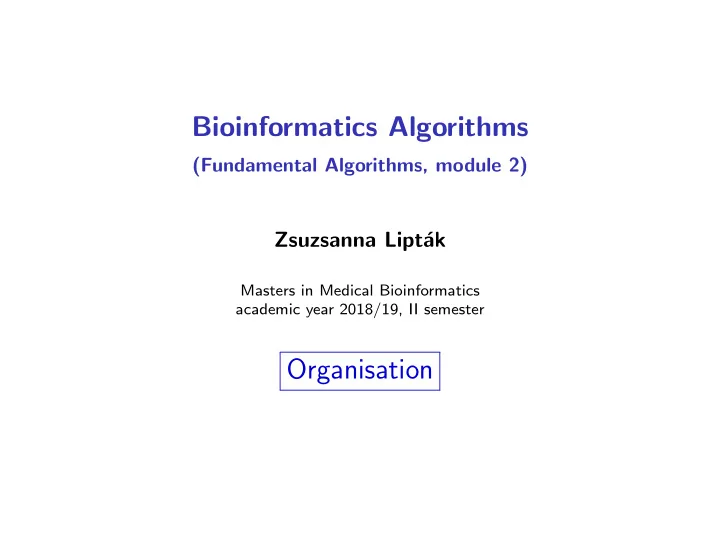

Bioinformatics Algorithms (Fundamental Algorithms, module 2) Zsuzsanna Lipt´ ak Masters in Medical Bioinformatics academic year 2018/19, II semester Organisation
Organisation • Title of course: Bioinformatics Algorithms (Fundamental Algorithms, module 2) Master of Medical Bioinformatics (MB) 6 CFU of a total of 12 CFU • This course doubles as ( mutuato ) Algorithms for Computational Biology in the Master in Medical and Molecular Biotechnology (MMB) 6 CFU 2 / 6
Organisation (cont.) • course times: Tue 12:30 - 14:30 (aula L), Thu 11:30 - 14:30 (aula A) • email: zsuzsanna.liptak@univr.it Please include the course title and your name in the email • office: CV 2, 1st floor, room 1.79 • student hours: Wed 10-12 (9:30-11:30?) and by appointment • webpage of course: http://profs.scienze.univr.it/~liptak/FundBA/ 3 / 6
Organisation (cont.) • exam: written and oral, admitted to oral only if you pass the written test • different exams for students of MB and MMB • There will be two extra lectures for students of MMB on computational complexity • takehome exercises during term: will be discussed but not marked • for Fundamental Algorithms final grade is 50% mod.1, 50% mod.2 4 / 6
Organisation (cont.) • exam: written and oral, admitted to oral only if you pass the written test • different exams for students of MB and MMB • There will be two extra lectures for students of MMB on computational complexity • takehome exercises during term: will be discussed but not marked • for Fundamental Algorithms final grade is 50% mod.1, 50% mod.2 Questions? 4 / 6
Overview (tentative) • Pairwise sequence analysis • Pairwise sequence alignment (global, local, other variants) • Pairwise alignment in practice: BLAST, Scoring matrices • String distances (edit distance, LCS distance, q -gram distance) 5 / 6
Overview (tentative) • Pairwise sequence analysis • Pairwise sequence alignment (global, local, other variants) • Pairwise alignment in practice: BLAST, Scoring matrices • String distances (edit distance, LCS distance, q -gram distance) • Sequence assembly algorithms • Sanger shotgun sequencing: SCS (recap) • Sequencing with de Bruijn graphs 5 / 6
Overview (tentative) • Pairwise sequence analysis • Pairwise sequence alignment (global, local, other variants) • Pairwise alignment in practice: BLAST, Scoring matrices • String distances (edit distance, LCS distance, q -gram distance) • Sequence assembly algorithms • Sanger shotgun sequencing: SCS (recap) • Sequencing with de Bruijn graphs • Multiple sequence alignment • DP-algorithm, SP-score • Heuristic and approximation algorithms 5 / 6
Overview (tentative) • Pairwise sequence analysis • Pairwise sequence alignment (global, local, other variants) • Pairwise alignment in practice: BLAST, Scoring matrices • String distances (edit distance, LCS distance, q -gram distance) • Sequence assembly algorithms • Sanger shotgun sequencing: SCS (recap) • Sequencing with de Bruijn graphs • Multiple sequence alignment • DP-algorithm, SP-score • Heuristic and approximation algorithms • Basics of Phylogenetics • distance-based data: UPGMA, Neighbor Joining • character-based data: Perfect Phylogeny, Small and Large Parsimony 5 / 6
Overview (tentative) • Pairwise sequence analysis • Pairwise sequence alignment (global, local, other variants) • Pairwise alignment in practice: BLAST, Scoring matrices • String distances (edit distance, LCS distance, q -gram distance) • Sequence assembly algorithms • Sanger shotgun sequencing: SCS (recap) • Sequencing with de Bruijn graphs • Multiple sequence alignment • DP-algorithm, SP-score • Heuristic and approximation algorithms • Basics of Phylogenetics • distance-based data: UPGMA, Neighbor Joining • character-based data: Perfect Phylogeny, Small and Large Parsimony • Introduction to string data structures • Basics of Suffix Trees and Suffix Arrays • Some applications 5 / 6
Books • Enno Ohlebusch : Bioinformatics Algorithms: Sequence Analysis, Genome Rearrangements, and Phylogenetic Reconstruction. Oldenbusch Verlag (2013) —recent, detailed, covers some but not all topics of this course, 3 copies in library • H.-J. B¨ ockenhauer, D. Bongartz : Algorithmic Aspects of Bioinformatics (2010) • V. M¨ akinen, D. Belazzougui, F. Cunial, A.I. Tomescu : Genome-Scale Algorithm Design. Cambridge University Press (2015)—very recent, advanced • Neil C. Jones and Pavel A. Pevzner : An Introduction to Bioinformatics Algorithms (2004)—3 copies in library • David M. Mount : Bioinformatics: Sequence and Genome Analysis (2004)—biologically oriented book, detailed, not always sufficiently algorithmic • Jo˜ ao Setubal, Jo˜ ao Meidanis : Introduction to Computational Molecular Biology (1997)—my old favorite but a bit dated, 1 copy in library • Dan Gusfield : Algorithms on Strings, Trees, and Sequences (1997)—the bible of string algorithms, a bit dated now • Joseph Felsenstein : Inferring Phylogenies (2004)—important book on phylogenetics, very understandably written • Cormen, Leiserson, Rivest (& Stein) : Introduction to Algorithms (different editions, 1990-onwards)—the bible of algorithms, a must-have for anyone interested in algorithms (buy second hand, old editions are also fine) 6 / 6
Recommend
More recommend